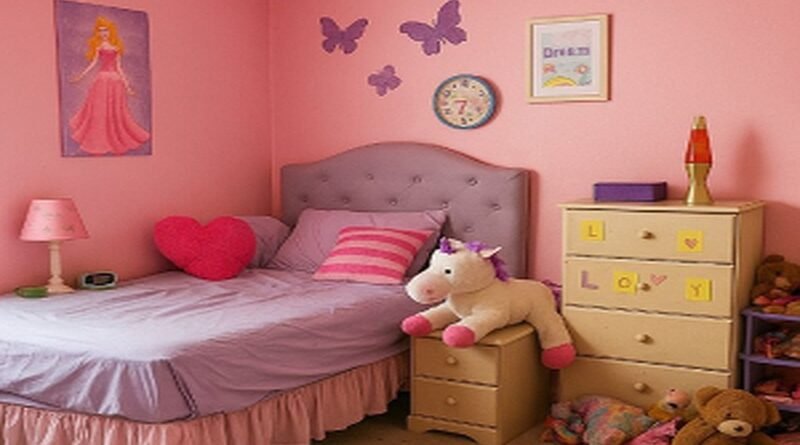Unattractive Girl’s Bedroom: Why Do Some Decorations Turn Out Disappointing?
However, in reality, some rooms do not inspire but instead create a feeling of chaos, clutter, and even visual fatigue. The truth is, there are common mistakes in designing such spaces that can turn the final result from “delightful” to “ugly.” In this article, you’ll learn all the ways to avoid having an unattractive bedroom, from selecting the rug to choosing the curtains. Stay with us until the end.Bedroom Rugand curtains. Please stay with us until the end.
Part One: Characteristics of an Ugly Girl’s Bedroom

The term “ugly” in decoration does not refer to an unpleasant appearance; it means a lack of harmony, aimlessness in design, or excessive decoration. We will now discuss the obvious signs of such spaces:
Excessive use of pink or purple colors

When these colors are used so extensively that everything looks like a candy box, it not only tires the eyes but also creates a childish feel that is not suitable for teenage or young girls. Based on this messy example above,Child’s Room Rugthey chose purple, which has become very dull. When choosing a rug for the room, think as carefully as you do about curtains.
Overdecorated Bedroom
Covering walls with cartoon stickers, hanging yarn ornaments, unrelated posters, and crowded shelves makes the space look chaotic. Remember, there is no need for the entire room to be full of items.
Blind imitation of trends:
Every room that looks beautiful on Instagram or Pinterest is not necessarily suitable for our space. Unplanned copying of decorative images can lead to spaces that lack identity. Choose wisely,the trending Red Rugwhich has become popular in modern decor and large rooms, makes a small bedroom feel even smaller.
Not matching the style and needs of the room:
An 8-year-old girl and an 18-year-old girl have different needs. Designing uniformly for all age groups results in a room that is neither practical nor enjoyable. Therefore, first consider your child’s current age when choosing the design.
Part Two: Common Mistakes in Design
Beyond appearance, design mistakes deeply affect the quality of the room’s space:
Ignoring the preferences and personality of the individual:
A successful design reflects the person’s real interests, not the wishes of the mother, designer, or seller. Consider which designs your child enjoys most and where they feel most comfortable.
Neglecting Room Lighting
Intense white light or dim yellow light can ruin the entire mood of the space. Poor lighting is one of the main reasons for visual ugliness in many rooms. Try to incorporate natural sunlight into the bedroom decor and avoid heavy curtains.
Mixing incompatible styles:
Combining a classic bed with a modern desk or traditional curtains is like wearing clothes with clashing patterns. Style mismatches are one of the most common reasons for ugliness in decor.
Ignoring room scale:
A large king-size bed in a 9-meter room, a full-length mirror next to a child’s wardrobe, or a 12-meter carpet all cause visual clutter and disorder.
Part Three: How to Save an Ugly Room?
Fortunately, with a few simple steps, you can transform the space:
Reassess the color palette: Instead of sticking to one color, combine soft shades with neutral colors like white, gray, beige, or light wood to create balance.
Reduce decorative elements in the bedroom:
Removing unnecessary accessories allows the space to breathe and eases the eyes.
Increase natural light: Moving heavy curtains aside and using simple windows can make the space brighter and appear larger.
Focus on functionality:
Select furniture that is both beautiful and practical—such as a bed with drawers, a desk with shelves, or a wardrobe with a mirrored door—to make the space smarter.
Pay attention to the personality details of the room’s owner:
Adding elements that reflect the person’s personality (such as a self-portrait, favorite books, or special photos) helps create identity.
Conclusion
Ugliness in decor does not always mean the absence of beauty; it is often the result of not understanding needs, neglecting harmony, or overdoing imitation. By paying attention to true needs, personal taste, and simple design principles, even a small and simple room can become a joyful, functional, and beautiful space. Sometimes, distancing ourselves from flashy decorations reveals genuine beauty.

